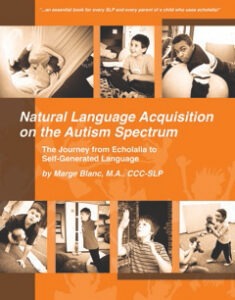M. Blanc: Thank you N of 1, Jennifer Cronk! You also are an N of 1, as you bravely forged ahead without a body of evidence to guide you! Kate Shapiro Flaxman paid tribute to you yesterday when she was quoted on the podcast, Talking with Tech, that adding favorite gestalts to the AAC systems of multi-modal communicators has been the game-changer for GLPs. She said she and every AAC specialist she has talked to, has seen gestalt-customization to exponentially-increase engagement and communication among these communicators. As she said, the N of 1 method of customizing AAC *individually* is what makes *all* of those systems work! I hope this is just the beginning of a beautiful collaboration among Jenn, Shubha Bala, and other leaders! [p.s. the podcast will air at the end of November]
N of 1: NLA (Stages 1-2), AAC (featuring “Speak for Yourself” app), and Multimodal Communication with a Guest ‘n of 1’:
“The Magic Formula?”
The title of this blog page lends well to sharing about other multimodal “n of 1’s” in this niche community of AAC and gestalt language processors (GLP). In actual scientific research, an ‘n of 1’ study consists of just one research participant where supports are trialed to see which are the most effective for that ‘one’ participant.
While in our journey in experimenting with programming high tech AAC customizations to support Stage 1 and 2 gestalt language development for N, lots of other families and therapists have also been testing out how to customize high tech AAC with different apps while meeting the needs of individuals who have a variety of abilities and distinctive interests.
The video posted here shows how another family customized Stage 1 and 2 gestalts in the Speak For Yourself app for their own child. Their multimodal communicator is a young preschooler who has had access to high tech AAC since before the age of 2 years old.
In this video, the parent does an amazing job of explaining how they have programmed very specific gestalt language tailored to their child’s unique interests as well as gestalts that are salient to their own family culture. While this family is supporting their child’s language development, they simultaneously continue to foster their child’s multimodal communication such as body based communication. Then they use what they observe during these multimodal communication interactions to determine what language matters most to their child.
So here we are two families with our multimodal children who are quite different in the following ways: the communication apps used (TouchChat Wordpower 108 on ipad ‘and’ Speak For Yourself on ipad), the AAC programming techniques such as the location of gestalts, age difference (12 years old ‘and’ 3 years old), the sources of multimedia resources used to extract gestalt language from (home videos, apps, songs ‘and’ apps, songs, books), and most importantly the Stage 1 and 2 gestalt language programmed into the high tech AAC is highly personalized to their separate individualities and family cultures.
Yet at the very same time, both of our children are quite similar because they are thriving multimodal communicators who use a wide variety of ways to commune with their loved ones. With all of the added individualized supports for GLP’s put into place, they are also both growing in their language development naturally.
Some people may ask what is the ‘formula’ for finding Stage 1 and 2 language to program in high tech AAC for nonspeaking gestalt language processors? The answer is… there is no magic formula. The “magic” is all of us observing and listening with deep, quiet intention to the person who the high tech AAC is actually for.
Having the ability to speak is not a prerequisite to finding out what gestalt language resonates with our multimodal GLP’s. We need to be watching for things like turning a head to the side in a moment of quiet stillness when a certain part of song comes on, it might be jumping up and down during a certain scene in a movie, it might be moving their bodies closer or further away when communication partners model potential gestalts, it might be moving their body faster or slower when they hear a garage door open and close, it might be tensing up their body or relaxing when a line of book is read to them, it might be pulling a communication partner’s hand towards what they like or pushing it away to decline, it might be engaging in part of *any* activity over and over again, and so, so much more. If we take the time to look for and validate all multimodal communication, they will let us know what gestalt language matters most to them.
(I want to give a big thank you to this family for graciously allowing this video to be shared here. Since the video was made by this family, they have reported that further changes to the high tech AAC are to come. I know I look forward to seeing how their customizations expand even more. To keep tabs on this family’s GLP/AAC journey please go follow their page “The North Star and the Compass – blog”)
